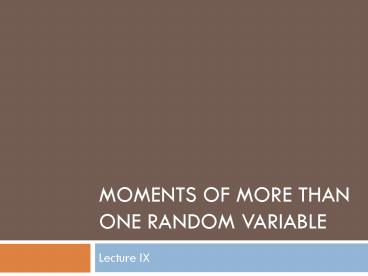Moments of More than One Random Variable - PowerPoint PPT Presentation
1 / 25
Title:
Moments of More than One Random Variable
Description:
MOMENTS OF MORE THAN ONE RANDOM VARIABLE. Lecture IX. Covariance and ... Note that the covariance between any random variable and a constant is equal to zero. ... – PowerPoint PPT presentation
Number of Views:33
Avg rating:3.0/5.0
Title: Moments of More than One Random Variable
1
Moments of More than One Random Variable
- Lecture IX
2
Covariance and Correlation
- Definition 4.3.1
3
- Note that this is simply a generalization of the
standard variance formulation. Specifically,
letting Y-gtX yields
4
- From a sample perspective, we have
5
- Together the variance and covariance matrices are
typically written as a variance matrix
6
Sample Variance Matrix
- Substituting the sample measures into the
variance matrix yields
7
Matrix Form of Sample Variance
- The sample covariance matrix can then be written
as
8
Theoretical Variance Matrix
- In terms of the theoretical distribution, the
variance matrix can be written as
9
Example 4.3.2
10
(No Transcript)
11
(No Transcript)
12
- Theorem 4.3.2. V(XY)V(X)V(Y)Cov(X,Y)
13
- Note that this result can be obtained from the
variance matrix. Specifically, XY can be
written as a vector operation
14
- Given this vectorization of the problem we can
define the variance of the sum as
15
- Theorem 4.3.3. Let Xi, i1,2, be pairwise
independent. Then
16
- The simplest proof to this theorem is to use the
variance matrix. Note in the preceding example,
if X and Y are independent, we have
17
- Extending this result to three variables implies
18
Correlation
- Definition 4.3.2. The correlation coefficient for
two variables is defined as
19
- Note that the covariance between any random
variable and a constant is equal to zero.
Letting Y equal to zero we have
20
Least Squares Regression
- We define the ordinary least squares estimator as
that set of parameters that minimizes the squared
error of the estimate
21
- The first order conditions for this minimization
problem then becomes
22
- Solving the first equation for a yields
- Substituting this expression into the second
first order condition yields
23
(No Transcript)
24
General Matrix Forms
25
- Theorem 4.3.6. The best linear predictor (or more
exactly, the minimum mean-squared-error linear
predictor) of Y based on X is given by aßX,
where a and ß are the least square estimates.































